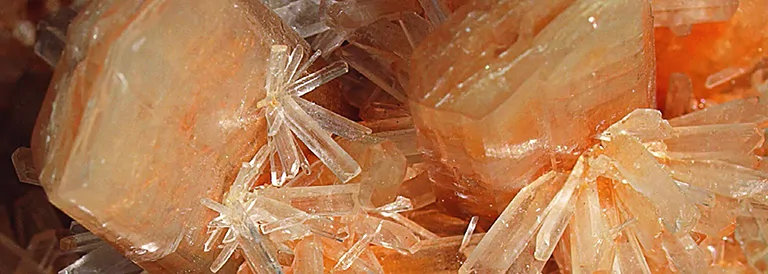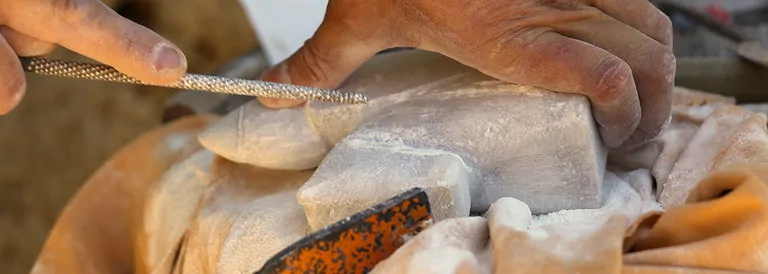
Alabaster - Meaning, effect and apllications
Alabaster can be valuable companion when there is much activity and busyness around us. External disturbances and distractions can be shielded so that we can remain completely with ourselves and rest in ourselves rest in ourselves. The view is directed inward, we reflect on our abilities and current tasks.
Alabaster and selenite - all gypsum?!
Gypsum is a material known from the building market, which is used as a base material for plasters, screeds and fillers, from which plasterboard panels are made and which is used as a filler. When mixed with lime, gypsum lime is formed, which is used primarily for elaborate stucco work.
In
mineralogy, gypsum or gypsum spar refers to a hydrous calcium sulfate with the chemical formula Ca[SO
4]-2H
2O from the mineral class of sulfates. Behind this sober definition are hidden especially
two popular minerals: Alabaster and Selenite. Alabaster is the microcrystalline variety of Gypsum, so it consists of very small grains (10-
7-10
-4 cm). Alabaster is rock-forming and can grow to several meters in size. Selenite (Fibre Gypsum) are gypsum crystals whose typical elongated structures are striking at first sight. Gypsum was elected
rock of the year 2022 by the Berufsverband deutscher Geowissenschaftler e.V.
Mineralogical profile Alabaster
Chemical formula: CaSO4 - 2H2O
Mineral Class: Sulfate
Color: gray, white, cream, light yellow, orange, reddish, brownish, greenish - depending on where it was found.
Gloss: matte
Crystal system: monoclinic
Moh hardness: 1.5 - 2
Splitability: no splitability, uneven, granular fracture
Origin of the name Alabaster and synonyms
Where the name "Alabaster" comes from, is not clear, but there are various theories: Possibly the term comes from the Egyptian and goes back to the city Albastron or the region Albastrites, in which Alabaster was already mined at that time. Hereof reported the Greek naturalist Theophrastos of Eresos (371 - c. 287 BC) in his writings.
Another conjecture is the derivation from the Greek word alabe ("without handle"), since they used to make from Alabaster handleless pots for the storage of creams. Also the derivation of ana(r) and bast(et), thus "stone of the Bastet" is a possibility, because the goddess Bastet was said that she possessed numerous vessels with cosmetics and make-up from Alabaster.
With the term "alabaster skin" is a very even, light, almost transparent-looking skin with velvety sheen. This was particularly in the Baroque period as an ideal of beauty.
Other names for alabaster are Alabastergips, Gypsum Alabastaum or also Gypsum Alabstrum.
Not to be confused is Alabaster with the so-called "Egyptian Alabaster" - this is the harder and water-insoluble onyx marble

Formation and occurrence of Alabaster
Alabaster, in most cases of its natural occurrence, is a sediment, which is often formed within salt lakes or isolated ocean basins during the evaporation of water. Alabaster may also be formed by the weathering of Sinter deposits or by oxidation processes in sulfide ore deposits,
Findings there are, among others, in Italy, Germany and Morocco. In Germany, Alabaster has been mined in Franconia, among other places, for centuries. The wine pressed from the grapes grown there is also called "Alabaster wine".
The most famous finding area for Alabaster is around the Italian city of Volterra; there is already mined by the Etruscans in pre-Christian times Alabaster. Today as lamps, tea lights and cut forms of selenite are mostly made from Moroccan selenite.
In the Middle Ages, the English sites in Staffordshire and Derbyshire (Midlands) were particularly important. Numerous works of art such as figures and altars , for example, for Henry IV (1367 - 1413) in the famous Canterbury Cathedral were created. Since the 1920s, English alabaster deposits have been depleted and in the meantime nature has reclaimed the area.
Impressive is the "Alabaster Cave", a good 1.2km long Alabaster cave in Oklahoma (USA). In Alabama (USA), the occurrence there gave its name to the town of Alabaster in Shelby County.
On the French Alabaster Coast in Normandy, the mineral does not occur; here, only the color of the mineral gave it its name.
Use of Alabaster
Because of its low hardness of 1.5 - 2, alabaster has been a sought-after material for the manufacture of vases, sculptures and other art objects for centuries. Alabaster is only suitable for indoor use due to its solubility in water. Cut into thin slices, Alabaster is often used for the construction of lamps due to its translucency. Alabaster also played a major role in the interior decoration of churches, e.g. altars. Thus, in the arid areas of central Spain, stained glass windows made of Alabaster have been common. One of the most famous sacred buildings with alabaster furnishings is the Salem Cathedral.

Application for Alabaster in gemstone healing
In stone healing, Alabaster is used to promote self-control and detachment, for stabilization, as a protective stone and for conscious awareness of old patterns.
Astrology knows Alabaster as a balancing stone for those born in the sign of Pisces (setting boundaries) and for those born in the sign of Cancer (for oversensitivity).


